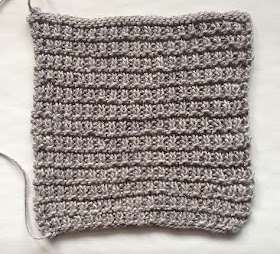A knitting blog about career transition, personal development and the search for fulfillment.
▼
Wednesday, February 3, 2016
All About Swatching
When I'm working on a new design I spend lots of prep time on the swatching process. The photo above is the swatch for a garment. It's the second swatch, I moved down a needle size when I decided the first swatch was a little too loose. I was happy with this one. The yarn is Blue Heron Rayon Metallic. It creates a gorgeous drapey fabric. I initially thought this stitch might not work as I've used rayons in the past which have flattened out too much for a knit-purl textured stitch to work.
This is my info sheet. I use graph paper, you might not be able to see the blue lines. I lay the swatch on it and draw around it. I use a pencil but I darkened it with pens so you can see the lines. I've noted the needle size I used. Next I steamed the swatch which showed no change in size. Then I washed it by hand and laid it flat to dry. I always follow the label instructions since knitters who use the same yarn I used in a pattern will most likely follow the label. My last step was to hang the swatch for 48 hours by standing up my blocking board. When I did this I got 1/2 inch of growth over 6 inches of knitting. When laid flat again the growth disappeared. You can calculate the growth in length for a garment by percentage but I will warn you, my experience tells me the growth percentage increases the larger the piece is. So this information will be an indication but not a firm number.
.5" / 6" = .084"
If my garment is 15 or 16 inches from hem to underarm the growth will be at minimum.
15" X 1.084" = 16.26"
16" X 1.084" = 17.34"
The way I handle this is to knit the garment about 2-3 inches short of the target number and then hang it for 48 hours to reassess. Once I've checked I'll adjust accordingly. I'll add details in my pattern to help the knitter. My schematic will reflect finished measurements. The pattern instructions will reflect shorter measurements. The pattern notes will list the amount of drop I got so the knitter can adjust according to their preferences and personal row gauge. I also do the same thing with linen, which shrinks so the knitter can adjust during the knitting. The last thing I do when I'm knitting for myself is to decide what is the shortest and longest length acceptable to me because fibre can surprise you and if I set my expectation up for a range of results I am more likely to be happy with the finished product.


No comments:
Post a Comment